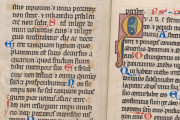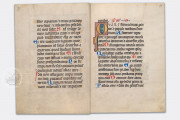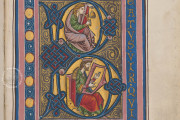Hailing from the environs of Lake Constance and dating from around 1260, the Rheinau Psalter is a splendid monument of thirteenth-century illumination. The manuscript is a beguiling masterpiece featuring the finest paint materials and parchment. The text, focused on the biblical book of Psalms, is illustrated with ten full-page miniatures, one full-page historiated initial, and nine large decorated initials. The manuscript showcases a unique palette dominated by dusty rose, sage green, and blue, generously highlighted in gold and silver.
Written in Latin, the Rheinau Psalter is a book designed for use in Christian devotion. It begins with a calendar, continues with the 150 Psalms, Old and New Testament canticles, and prayers, and concludes with a litany.
Masterful Miniatures
Following both the eight- and three-fold divisions of the psalms, the ten miniatures (of an original twelve) depict episodes from the life of Christ and the Church extending from the Annunciation to the Virgin (fol. 7v) to the Last Judgment (fol. 145v). The stunning compositions are set within painted frames dotted with gold and silver. They feature monumental figures with delicately curled locks and voluminous garments. The scenes are set on backgrounds of burnished gold, often incised with ornamental motifs.
Large Painted Interlace Initials
The miniatures precede opulent painted initials. The Beatus initial of Psalm 1 shows the Israelite King David, the purported author of the psalms, playing the harp and accompanied by a bellringer (fol. 10r). The remaining nine are formed of intricate vegetal interlace.
A Golden Initial for Each Psalm
The script is Gothic Textualis, written by more than one scribe. Each psalm not given special treatment opens with a three- to four-line initial in gold (or sometimes silver) on a decorated background, and each verse begins with a capital letter in alternating blue and red ink. The blue here is the exorbitantly expensive and scarcely available lapis lazuli.
From the Lake Constance Region
The manuscript's early history is untraced. It may have been made for a wealthy patron in Constance. Its first known owner is Johannes Melchior Kirchhofer (1736-1837). In 1817, Blasius Hauntinger (1762-1826) purchased the manuscript for the Benedictine abbey at Rheinau. In 1863, the Rheinau abbey library became part of Zurich's Kantonsbibliothek (today Zentralbibliothek).
Remnants of the Original Binding
The current binding of brown leather of nineteenth- or twentieth-century date probably incorporates the manuscript's original wooden boards. Also original is the page-edge decoration of spiral motifs in gold leaf.
We have 1 facsimile edition of the manuscript "Rheinau Psalter": Der Rheinauer Psalter: Meisterwerk der Buchmalerei um 1260 facsimile edition, published by Quaternio Verlag Luzern, 2013
Request Info / Price








